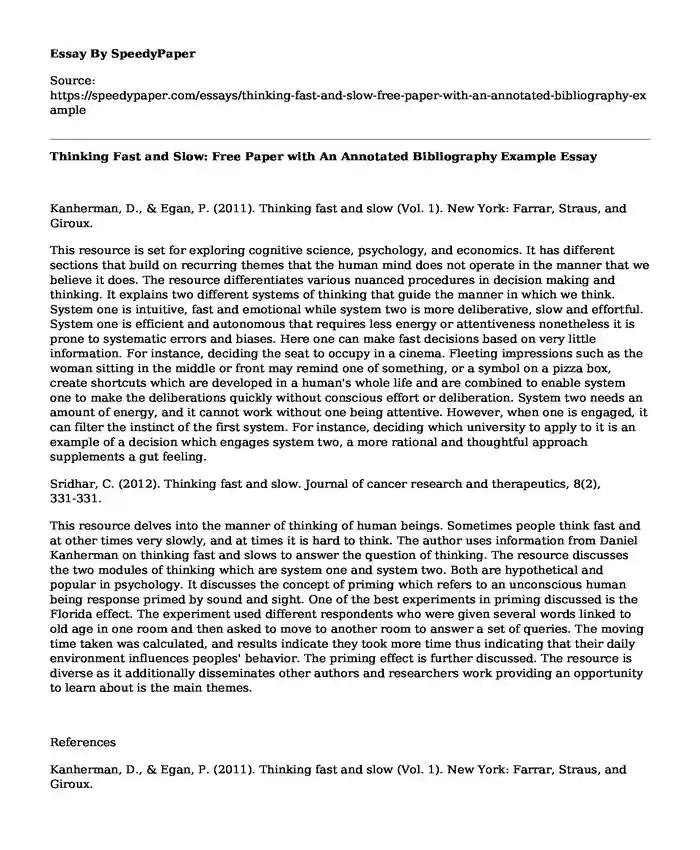
| Type of paper: | Annotated bibliography |
| Categories: | Psychology |
| Pages: | 2 |
| Wordcount: | 470 words |
Kanherman, D., & Egan, P. (2011). Thinking fast and slow (Vol. 1). New York: Farrar, Straus, and Giroux.
This resource is set for exploring cognitive science, psychology, and economics. It has different sections that build on recurring themes that the human mind does not operate in the manner that we believe it does. The resource differentiates various nuanced procedures in decision making and thinking. It explains two different systems of thinking that guide the manner in which we think. System one is intuitive, fast and emotional while system two is more deliberative, slow and effortful. System one is efficient and autonomous that requires less energy or attentiveness nonetheless it is prone to systematic errors and biases. Here one can make fast decisions based on very little information. For instance, deciding the seat to occupy in a cinema. Fleeting impressions such as the woman sitting in the middle or front may remind one of something, or a symbol on a pizza box, create shortcuts which are developed in a human's whole life and are combined to enable system one to make the deliberations quickly without conscious effort or deliberation. System two needs an amount of energy, and it cannot work without one being attentive. However, when one is engaged, it can filter the instinct of the first system. For instance, deciding which university to apply to it is an example of a decision which engages system two, a more rational and thoughtful approach supplements a gut feeling.
Sridhar, C. (2012). Thinking fast and slow. Journal of cancer research and therapeutics, 8(2), 331-331.
This resource delves into the manner of thinking of human beings. Sometimes people think fast and at other times very slowly, and at times it is hard to think. The author uses information from Daniel Kanherman on thinking fast and slows to answer the question of thinking. The resource discusses the two modules of thinking which are system one and system two. Both are hypothetical and popular in psychology. It discusses the concept of priming which refers to an unconscious human being response primed by sound and sight. One of the best experiments in priming discussed is the Florida effect. The experiment used different respondents who were given several words linked to old age in one room and then asked to move to another room to answer a set of queries. The moving time taken was calculated, and results indicate they took more time thus indicating that their daily environment influences peoples' behavior. The priming effect is further discussed. The resource is diverse as it additionally disseminates other authors and researchers work providing an opportunity to learn about is the main themes.
References
Kanherman, D., & Egan, P. (2011). Thinking fast and slow (Vol. 1). New York: Farrar, Straus, and Giroux.
Sridhar, c. (2012). Thinking fast and slow. Journal of cancer research and therapeutics, 8(2), 331-331.
Cite this page
Thinking Fast and Slow: Free Paper with An Annotated Bibliography Example. (2022, Oct 04). Retrieved from https://speedypaper.com/essays/thinking-fast-and-slow-free-paper-with-an-annotated-bibliography-example
Request Removal
If you are the original author of this essay and no longer wish to have it published on the SpeedyPaper website, please click below to request its removal:
- Jakarta City Development in a Free Essay Example
- Free Essay on a Third Tier Workforce Inclusion in Nursing Management
- Paper Sample on Essay Writing
- Free Essay on Growing Up as Homosexual
- Was the Progressive Era the Second American Revolution?
- Assignment Example on Individual Responsibility and State Responsibility
- Research Paper on UnitingCare Ballarat
Popular categories




